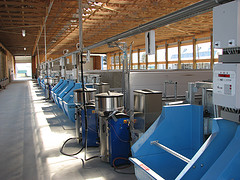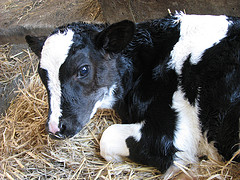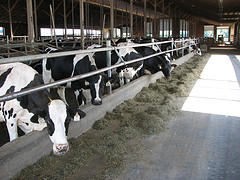Providing quality care for recumbent (‘downer’) cows is a crucial role for the modern dairy farmer. Cases of poor quality care can harm both the cow and the reputation of the dairy industry. Providing good care can be both time- and labour-intensive. Producers must choose between available treatments, how to relocate the cow in the sick pen, what type of nursing to provide, and when to abandon treatment and euthanize the cow if treatment is ineffective. Unfortunately, there is little research regarding best practices for managing and treating downer cows, leaving producers and veterinarians to rely on their personal experience.
Cows that are unable or unwilling to stand and remain recumbent for more than 12 h are typically defined as non-ambulatory or “downer” cows. The condition typically begins with a primary cause such as hypocalcaemia (milk fever), injury or trauma during parturition. Lack of movement in the hours that follow can then cause additional problems, including ischemic damage to the pelvic muscles and nerves that make it impossible for the cow to rise. This secondary damage can be fatal, and producers rightly recognize that helping the cow stand can prevent this damage and assist recovery.
Dairy producers use a range of tools to help cows stand, including hip clamps, slings and air bags. These methods have drawbacks: hip clamps are associated with pressure necrosis on the hook bone and slings and air bags can increase pressure on the abdominal organs and the diaphragm, compromising respiration. A recent UBC study investigated another option: flotation therapy. This method involves moving the cow into a water-tight chamber that is filled with warm water. The idea is to use the buoyancy of the water to evenly support the cows’ body and help her stand. The warm water provides an additional therapeutic effect on muscles and nerves damaged during the extended lying period before treatment. The aims of this study were to identify which cows are most likely to benefit from this treatment, and to describe other factors that contribute to a downer cow successful recovery.
Commercial dairy producers in the lower Fraser Valley region of British Columbia were asked to enrol in the study whenever they identified a cow as a downer. A total of 34 dairy cows were enrolled in the study. Before treatment, a veterinarian performed a detailed physical examination. Alert cows that maintained sternal recumbency, were willing to eat, and showed initiative to stand up were included in the study. General information about the cow was recorded, including her medical history and the amount of time she had been down before treatment. We also evaluated the ‘nursing care’ of the downer cow using a combination of five factors: careful placement, use of a segregated sick pen with provision of deep and dry bedding, access to feed and water, and regular repositioning.
Enrolled cows were placed onto a rubber mat which was pulled into the tank. The tank was filled with 2400 L of previously heated water. Cows were “floated” (such that they could stand comfortably on all four limbs) for an average of 8 h, during which they had access to feed and drinking water. Cows that were unable to stand comfortably on all four limbs during the flotation, or that did not show any initiative to eat, were recommended for euthanasia. Twelve hours after the flotation treatment (and the cow left the tank), the veterinarian re-assessed the cow’s condition. In cases where the cow was observed to have improved but became non-ambulatory in the hours that followed, an additional treatment was recommended.

Figure 1. The percentage of recovery of downer cows following treatment in the flotation tank, relative to the time that cows had been recorded as recumbent before treatment was initiated. Recumbency duration is presented in 12 h intervals.
The quality of nursing care provided to the downer cows while recumbent had a profound effect on the outcome of the treatment. Approximately 70% of the cows that received good nursing care recovered after undergoing flotation therapy. In contrast, almost 90% of the cows that were provided with poor nursing care failed to recover after the treatments.
The time between when cows first went down and when the flotation treatment begun was also crucial. Cows that were recumbent for 24 h or less before treatment were more likely to recover following flotation therapy (Figure 1). Indeed, the chances that the flotation treatment resulted in recovery of the downer cow declined with every hour that treatment was delayed. Cows recumbent for 48 h had 50% chances for recovery, the best outcomes were for cows treated within 12 h of recumbency.
The longer the duration of recumbency, the greater the risk of secondary compression. This damage is especially likely to affect the large muscles of the pelvic limbs that are often positioned under the cow’s body.
In conclusion, the chances of recovery were higher if the flotation therapy started sooner and cows received good nursing care while recumbent; including careful movement and repositioning, use of a comfortable, well bedded sick pen and access to feed and water. We advise producers to have an up-to-date standard operating procedure outlining best practices of how to manage and care for non-ambulatory cows, and a decision tree that will assist when reaching a final decision for treatment or euthanasia in the early stage of recumbency.
We are grateful to Yanne Stojkov for his help in preparing this report. For further information, email marina.vonkeyserlingk@ubc.ca or dan.weary@ubc.ca. Report is based on research published in JDS (Stojkov et al. 2016. JDS 99:2076-2085 http://dx.doi.org/10.3168/jds.2015-10448.) We thank the veterinarians from Agwest Veterinary Group who collaborated in the work described in this report. Funding for this project was provided by Agriculture and Agri-Food Canada and the British Columbia Ministry of Agriculture through the Canada-BC Agri-Innovation Program under Growing Forward 2, a federal-provincial-territorial initiative. The program is delivered by the Investment Agriculture Foundation of BC. Additional funding provided by WestGen and Agwest Veterinary Group. Research by members of UBC’s Animal Welfare Program funded by NSERC, the Canadian Dairy Commission, Dairy Farmers of Canada and many others listed at awp.landfood.ubc.ca.





